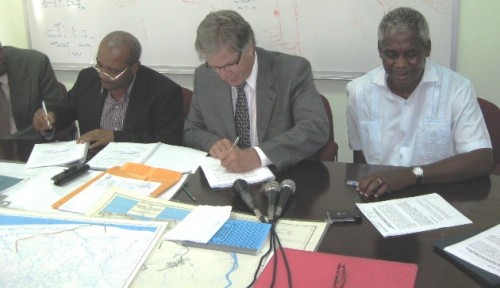The Guyana Civil Aviation Authority (GCAA) yesterday signed a US$3.5 million ($700 million) contract with Canadian company Intelcan Technosystems Inc, which will see the upgrading of communication and air-navigation systems at the Cheddi Jagan International Airport, Timehri.
The contract will see the replacement of equipment over an 18-month period in what is the first phase of a project to modernise the airport systems.
It was signed yesterday between Director of Business Development of Intelcan Bernard Goyette and Permanent Secretary Balraj Balram in the office of Transport and Hydraulics Minister Robeson Benn.
Benn said that the project is being funded by the Government of Guyana and emphasised that the government was working hard to improve aviation systems and their oversight and to bring them up to modern standards. Benn noted that the equipment currently being used for communications and air navigation systems was 25 to 30 years old. He said modern systems were necessary since the flight traffic over Guyana has increased significantly over the years. He said this project ties in with an effort to improve the aviation sector in the country.
Interim Director General of the GCAA Zulficar Mohamed explained that initially work will be done on improving radio communication equipment, which is responsible for air-to-ground communication as well as facility-to-facility communication, along with communication with contiguous states. He emphasized that the equipment that the control tower currently has is functioning, but added that the new equipment will be state-of-the-art.

He disclosed that the new equipment will include a total Air Traffic Management (ATM) which is an automated system capable of presenting information to air traffic controllers and which is interfaced with other communication components.
In terms of new navigation equipment, Mohamed said a high-powered Distance Measuring Equipment (DME) system will be acquired. He said the equipment currently in use can only give information on direction. With the new DME, it will be easier for air traffic controllers to provide specific directions for aircraft operating in the air space.
Mohamed also said that the Instrument Landing System (ILS) equipment, that will be acquired, will help to provide precision approach guidance for aircraft landing, since it will be able to bring the aircraft down to 200 feet above the ground.
The acting director general said that the new Automated Weather Observation System (AWOS) will provide information on the weather on a real-time basis. This will provide real-time information on pressure, wind speed, direction, temperature, due point, runway visual range and cloud base. Under the current system, the local Meteorological Office provides all this information on an hourly basis to the airport authorities.
According to Mohamed, the second phase of the project will consist of the provision of miscellaneous equipment and he said they are examining the possibility of this commencing immediately after the first phase is completed.
The project was advertised last year in the local and international press. The latter option was chosen so as to attract foreign bidders because of the nature and complexity of the project which demanded experience in similar projects as a requirement. This project is expected to create the foundation and infrastructure on which future capabilities will be added, when necessary.
It was noted that through this programme, the Guyana Civil Aviation will ensure that Guyana continues to meet all of its obligations to International Civil Aviation Organization (ICAO) air navigation.
Goyette said his company was pleased to be associated with the project. He pointed out that Intelcan Technosystems Inc was involved in the original effort to procure and install a major part of the equipment at the airport back in 1982.
He described the current project as “a breath of fresh air” for the local aviation industry since it would see the updating of equipment “which is near the end of its useful life cycle”.
Intelcan, which has been in existence since 1973, is touted on its website as a global leader in the field of Air Traffic Control (ATC) and Aviation Infrastructure. The company manufactures, supplies, and integrates Communications, Navigation, Surveillance, and Air Traffic Management (CNS/ATM) solutions customized for the specific requirements of each of customer, military or civilian in accordance with IS0 9001:2000 Quality Management Standards.
It has customers in over 60 countries around the world and works in partnership with its customers to improve the safety and efficiency of their Air Traffic Control Systems.
A report done last year by captain Gregory Fox at the invitation of the Director General of the Guyana Civil Aviation Authority (GCAA) said that Air Traffic Controllers “are forced to work with unserviceable, obsolete and inadequate equipment”.
“Guyana’s ATC and air navigation system has such serious equipment deficiencies coupled with a controller shortage that the required standard of safety in Guyanese airspace cannot be guaranteed,” the report said.
Because of this lack, the report pointed out, many Air Traffic Controllers are working up to 60 hours of overtime per month. This situation is “very likely resulting in cumulative fatigue”, the report said.
In its most searing indictment, the Fox report said that the fact that the Air Traffic Control (ATC) system works at all is due to the dedication of the professionals in the ATC branch and their innovative technicians.
“They are all working under relatively primitive conditions with a shortage of trained staff, having trouble attracting and retaining suitable recruits…They are forced to work with unserviceable, obsolete and inadequate equipment and a lack of spares, lack of navigation aids, especially DME”.
It called for the urgent installation of DME at Timehri. “Repeat for emphasis: on an urgent basis a DME should be installed at Timehri”.
The report also appealed for urgent real time anemometer and barometric information to Timehri controllers and replacement of the headsets and cords in the air traffic control units.





